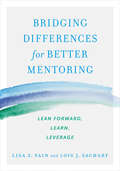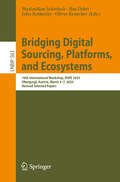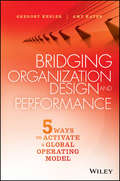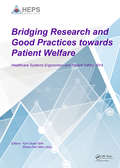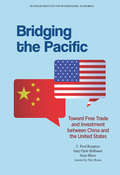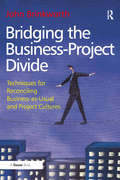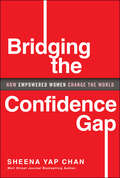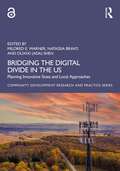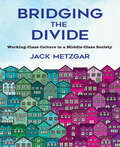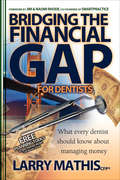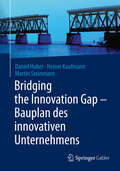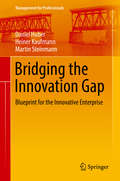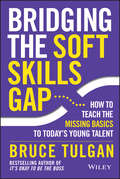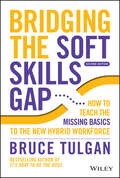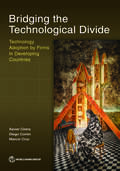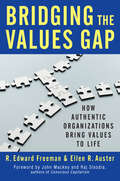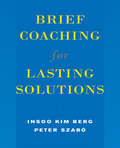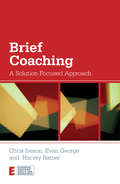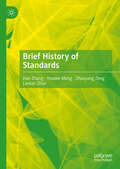- Table View
- List View
Bridging Differences for Better Mentoring: Lean Forward, Learn, Leverage
by Lois J. Zachary Lisa Z. FainThis first comprehensive guide to helping mentors and mentees bridge gaps between and among cultures—a growing issue in today's diverse workplace—is coauthored by the founder and CEO of the Center for Mentoring Excellence.As the workplace has become more diverse, mentoring has become more challenging. Mentors and mentees may come from very different backgrounds and have limited understanding of each other's cultures and outlooks. But mentoring remains the most powerful tool for creating meaningful relationships, furthering professional development, and increasing engagement and retention. Younger workers and emerging leaders in particular are demanding it. Lisa Z. Fain and Lois J. Zachary offer a timely, evidence-based, practical guide for helping mentors develop the level of cultural competency needed to bridge differences. Firmly rooted in Zachary's well-known four-part mentoring model, the book uses three fictional scenarios featuring three pairs of diverse mentors and mentees to illustrate how key concepts can play out in real life. It offers an array of accessible tools and strategies designed to help you increase your self-awareness and prepare you to embrace and leverage differences in your mentoring relationships. But beyond tips and techniques, Fain and Zachary emphasize that authenticity is the key—the ultimate purpose of this book is to help the mentor and mentee make a genuine connection and learn from each other. That's when the magic really happens.
Bridging Digital Sourcing, Platforms, and Ecosystems: 16th International Workshop, DSPE 2025, Obergurgl, Austria, March 4–7, 2025, Revised Selected Papers (Lecture Notes in Business Information Processing #563)
by Julia Kotlarsky Ilan Oshri Oliver Krancher Maximilian SchreieckThis book constitutes revised selected papers from the 15th International Global Sourcing Workshop 2025, held in Obergurgl, Austria, in March 2025. Following an introductory chapter by the volume editors, the 9 full papers included in this book were carefully reviewed and selected from 20 submissions. The book offers a review of the key topics that bridge the sourcing, digital platforms and ecosystems literatures, populated with practical frameworks that serve as a tool kit to managers and students. The range of topics covered in this book is wide and diverse, offering various perspectives on digital platforms, ecosystems and sourcing from both behavioural and design perspectives. More specifically the book sheds light on how sourcing decisions and digital platforms interact, their relevance for innovation and the governance of digital technologies in ecosystem settings. This book is a must read for any researcher and manager whose interest is in advancing knowledge sourcing, platforms and ecosystems.
Bridging Organization Design and Performance
by Gregory Kesler Amy KatesFive practical steps to enhance organization effectiveness on a global scale Bridging Organization Design and Performance is a handbook for leaders looking to enhance the success of their organizations and themselves. Companies that compete globally require organizational operating models as robust as their strategies. Many companies have created elegant designs and consider their worldwide, matrix organizations sources of competitive advantage. However, the reality is that these complex structures bring many challenges and senior executives are often frustrated by the difficulties of delivering growth in organizations that span numerous brands, products, and geographic regions. After working closely with over twenty large US and Europe based global companies during the past decade, Gregory Kesler and Amy Kates concluded that the problem is not in the fundamental design of these operating models. The matrix is not going away. The challenge is to effectively and completely activate the organization to deliver the strategy. This book shares the five practical actions that bring complex organizations to life and help companies gain sustainable results from their global operating models.
Bridging Research and Good Practices towards Patients Welfare: Proceedings of the 4th International Conference on Healthcare Ergonomics and Patient Safety (HEPS), Taipei, Taiwan, 23-26 June 2014
by Yuh-Chuan Shih Sheau-Farn Max LiangErgonomics is a human-centered discipline. This is particularly true for healthcare systems and patient safety where the human‘s well-being will undergo critical impacts if solutions are not properly designed and practiced. Effective handling of these concerns involves knowledge from healthcare work (e.g., shift work, patient handling, and medical
Bridging The Pacific: Toward Free Trade and Investment Between China and the United States
by Gary Clyde Hufbauer C. Fred Bergsten Sean MinerThe terrain of the world trading system is shifting as countries in Asia, Europe, and North America negotiate new trade agreements. However, none of these talks include both China and the United States, the two biggest economies in the world. In this pathbreaking study, C. Fred Bergsten, Gary Clyde Hufbauer, and Sean Miner argue that China and the United States would benefit substantially from a bilateral free trade and investment accord. In the process, they contend, each country would also achieve progress in addressing its internal economic challenges, such as the low saving rate in the United States. Achieving greater trade and investment integration could be accomplished with one comprehensive effort or through step-by-step negotiations over key issues. The authors call on the United States to seek liberalization of China's services sector as vital to securing an agreement, and they explain that such contentious matters as cyberespionage and currency manipulation be handled through parallel negotiations rather than in the agreement itself. This is an important study of the benefits and difficulties of a complex matter that could yield dividends to the two economies and help stabilize the security and well-being of the rest of the world.
Bridging the Business-Project Divide: Techniques for Reconciling Business-as-Usual and Project Cultures
by John BrinkworthIn organizations these days, there are two cultures, two sets of expectations, two languages; that of the business-as-usual organization and separately that of projects. These cultures need to work together effectively. Unfortunately, the natural side-effect of two such different perspectives is misunderstanding, mutual incomprehension, and despite good intentions on both sides, failure to deliver desired benefits. In Bridging the Business-Project Divide John Brinkworth tackles these issues by examining: ·
Bridging the Confidence Gap: How Empowered Women Change the World
by Sheena Yap ChanA roadmap to self-confidence for women in leadership Bridging the Confidence Gap: How Empowered Women Change the World is a startlingly insightful and inspiring discussion of female leadership by celebrated executive, business leader, and author Sheena Yap Chan. Yap Chan delivers a transformative and fresh take on the challenges, pitfalls, and opportunities women face when they reach for the reins of leadership in business. She walks you through how to navigate those challenges and realize those opportunities with powerful observations drawn from a lifetime in business. You'll learn to level-up your career as you discover how to increase your courage and promote yourself, just as you explore the benefits to you, your organization, and society that come from you taking on a leadership role. You'll also find: A formula for women's leadership you can replicate in your own life and job Strategies for celebrating your remarkable achievements and supporting others in their own journeys through leadership Techniques for overcoming imposter syndrome and the double standards that women face in the workplace Perfect for managers, executives, board members, entrepreneurs, founders, and other other women in leadership roles, Bridging the Confidence Gap is a must-read for all professionals interested in a female perspective on the challenges and opportunities of leadership for women in business.
Bridging the Digital Divide in the US: Planning Innovative State and Local Approaches (Community Development Research and Practice Series)
by Mildred E. Warner Natassia A. Bravo Duxixi ShenThe US faces a deep digital divide which cuts across both urban and rural lines, but is most marked in rural, low income, and minority communities. This book presents a multi-level governance framework which explores how local leaders use policy opportunity and community resilience to address inequity in broadband infrastructure. Cases from communities across the US are profiled to show how local and regional initiatives address the digital divide – how they harness local resources, state and federal funding, and how they navigate regulatory restrictions and financial constraints. Special attention is given to rural and Indigenous communities, where the technological, organizational, and funding challenges are greatest. The federal policy landscape for broadband is changing, and this book provides clear insights on how policy can support the people and places left behind. This book is essential for planners and those studying or working in rural development, rural studies, and community development.The Open Access version of this book, available at www.taylorfrancis.com, has been made available under a Creative Commons Attribution-Non Commercial (CC-BY-NC) 4.0 license.
Bridging the Divide: Working-Class Culture in a Middle-Class Society
by Jack MetzgarIn Bridging the Divide, Jack Metzgar attempts to determine the differences between working-class and middle-class cultures in the United States. Drawing on a wide range of multidisciplinary sources, Metzgar writes as a now middle-class professional with a working-class upbringing, explaining the various ways the two cultures conflict and complement each other, illustrated by his own lived experiences.Set in a historical framework that reflects on how both class cultures developed, adapted, and survived through decades of historical circumstances, Metzgar challenges professional middle-class views of both the working-class and themselves. In the end, he argues for the creation of a cross-class coalition of what he calls "standard-issue professionals" with both hard-living and settled-living working people and outlines some policies that could help promote such a unification if the two groups had a better understanding of their differences and how to use those differences to their advantage. Bridging the Divide mixes personal stories and theoretical concepts to give us a compelling look inside the current complex position of the working-class in American culture and a view of what it could be in the future.
Bridging the Financial Gap for Dentists: What Every Dentist Should Know About Managing Money
by Larry MathisLarry Mathis, CFP® has been working dental professionals for more than 17 years. His wealth of experience has enabled him to help simplify and improve the lives of dental professionals by inspiring them to implement financial strategies based upon what they value most in life! You've already chosen a great profession! Bridging The Financial Gap for Dentists will help you discover how to live your life based upon those things that you value most and encourage you to develop a financial strategy today to help you enjoy what you value to the fullest both today and in the future. Bridging The Financial Gap for Dentists is full of practical application techniques to help you maximize your wealth potential and avoid costly mistakes commonly made by dental professionals. Bridging The Financial Gap for Dentists will help you achieve your personal and financial goals in the time frame you are hoping for and it will give you simple steps that you can implement now to improve your immediate financial situation. If you have been wondering, "Does my financial planner really have my best interest in mind?" Bridging the Financial Gap for Dentist, will give you the knowledge to know whether you are working with a true financial professional or just another financial "sales person." "This is it! This is the key to successful financial planning! This is the key to staying out of debt! This is the key to accumulating wealth! This is the key to reducing financial stress in your life. Are you ready to start enjoying the fruits of your labor without eating every grape on the bowl? Read Bridging the Financial Gap for Dentist today!
Bridging the GAAPs
by Gwen YuInconsistencies in accounting treatment across countries are a major obstacle for global equity investment. Adoption of a single accounting standard (IFRS) has been received with much excitement, where apples to apples comparison across countries will become easier. However, adopting a global accounting standard may not necessarily mean that financial reporting in all countries will become standardized. Taking an example from HOLT, a private sector that offers standardized data for global portfolio investment, the case examines i) HOLT's adjustment process for differences in local accounting standards and ii) how IFRS adoption could change HOLT's global valuation framework. The case offers an interesting setting to examine how harmonizing accounting standards can affect global equity valuation.
Bridging the Innovation Gap - Bauplan des innovativen Unternehmens: Blueprint For The Innovative Enterprise (Management for Professionals)
by Daniel Huber Heiner Kaufmann Martin SteinmannInnovation wird zunehmend zum wichtigsten Erfolgsfaktor von Unternehmen. Die etablierten Innovationssysteme funktionieren allerdings vielerorts nicht. Zahlreiche Innovationsvorhaben scheitern aus nicht erklärbaren Gründen. Basierend auf ihrer langjährigen industriellen Praxis identifizieren die Autoren Lücken und Irrtümer im bisherigen Verständnis des Innovationsvorgangs und stellen erstmals ein funktionierendes und durchgängiges Innovationssystem vor. Dieses wegweisende ,,Berner Innovationsmodell" überbrückt den ,,Innovation Gap" und hat das Potenzial, Unternehmen zu nachhaltigem Erfolg zu führen.
Bridging the Innovation Gap: Blueprint for the Innovative Enterprise (Management for Professionals)
by Daniel Huber Heiner Kaufmann Martin SteinmannInnovation wird zunehmend zum wichtigsten Erfolgsfaktor von Unternehmen. Die etablierten Innovationssysteme funktionieren allerdings vielerorts nicht. Zahlreiche Innovationsvorhaben scheitern aus nicht erkl#65533;rbaren Gr#65533;nden. Basierend auf ihrer langj#65533;hrigen industriellen Praxis identifizieren die Autoren L#65533;cken und Irrt#65533;mer im bisherigen Verst#65533;ndnis des Innovationsvorgangs und stellen erstmals ein funktionierendes und durchg#65533;ngiges Innovationssystem vor. Dieses wegweisende ,,Berner Innovationsmodell" #65533;berbr#65533;ckt den ,,Innovation Gap" und hat das Potenzial, Unternehmen zu nachhaltigem Erfolg zu f#65533;hren.
Bridging the Pacific: Toward Free Trade and Investment Between China and the United States
by Gary Clyde Hufbauer C. Fred Bergsten Sean MinerThe terrain of the world trading system is shifting as countries in Asia, Europe, and North America negotiate new trade agreements. However, none of these talks include both China and the United States, the two biggest economies in the world. In this pathbreaking study, C. Fred Bergsten, Gary Clyde Hufbauer, and Sean Miner argue that China and the United States would benefit substantially from a bilateral free trade and investment accord or from participating together in a regional agreement like the TPP. In the process, they contend, each country would also achieve progress in addressing its internal economic challenges, such as the low saving rate in the United States. Achieving greater trade and investment integration could be accomplished with one comprehensive effort or through step-by-step negotiations over key issues. The authors call on the United States to seek liberalization of China's services sector as vital to securing an agreement, and they explain that such contentious matters as cyberespionage and currency manipulation be handled through parallel negotiations rather than in the agreement itself. This is an important study of the benefits and difficulties of a complex matter that could yield dividends to the two economies and help stabilize the security and well-being of the rest of the world.
Bridging the Soft Skills Gap
by Bruce TulganSolve the number one problem with today's young workforce--the soft skills gap The number one challenge with today's young talent is a problem hiding in plain sight: the ever-widening soft skills gap. Today's new, young workforce has so much to offer--new technical skills, new ideas, new perspective, new energy. Yet too many of them are held back--and driving the grown-ups crazy--because of their weak soft skills. Here's what managers say: "They just don't know how to behave professionally" "They arrive late, leave early, dress inappropriately, and spend too much time on social media" "They know how to text but they don't know how to write a memo" "They don't know what to say and what not to say or how to behave in meetings" "They don't know how to think, learn, or communicate without checking a device" "They don't have enough respect for authority, and don't know the first thing about good citizenship, service, or teamwork" Soft skills may be harder to define and measure than hard skills, but they are just as critical. People get hired because of their hard skills but people get fired because of their soft skills. Managers ask: "Why should it be my problem to teach these soft skills? They should have learned these things from their parents or in school. How can teach these soft skills when I don't even remember how I learned them myself?" Here's the bad news: Setting a good example or simply telling young workers they need to improve isn't enough, nor is scolding them or pointing out their failings in an annual review. Here's the good news: You can teach the missing basics to today's young talent. Now, based on more than twenty years of research, Bruce Tulgan, renowned expert on the millennial workforce, offers concrete solutions to help managers teach the missing basics of professionalism, critical thinking, and followership--complete with ninety-two step-by-step lesson plans designed to be highly flexible and easy to use. Tulgan's research and proven approach has show that the key to teaching young people the missing soft skills lies in breaking down critical soft skills into their component parts, concentrating on one small component at a time, with the help of a teaching-style manager. Almost all of the exercises can be done in less than an hour within a team meeting or an extended one-on-one. The exercises are easily modified and customized and can be used in many different ways: as take-home exercises for any individual or group to guide one-on-one discussions with direct-reports in the classroom as written exercises or group discussions Managers--and their young employees--will find themselves returning to their favorite exercises over and over again. One exercise at a time, managers will build up the most important soft skills of their new, young talent. These critical soft skills can make the difference between mediocre and good, between good and great, between great and one of a kind.
Bridging the Soft Skills Gap: How to Teach the Missing Basics to the New Hybrid Workforce
by Bruce TulganNurture and develop well-rounded team players by focusing on soft skills development People entering the professional world are better educated than ever before. Their technical skills are often off-the-charts, helping them make short work of even the most challenging tasks. At the same time, however, many of these very same people lack soft skills we&’ve often taken for granted. In the newly revised second edition of Bridging the Soft Skills Gap: How to Teach the Missing Basics to the New Hybrid Workforce, veteran business advisor, speaker, and consultant Bruce Tulgan delivers a practical and incisive roadmap to developing crucial professionalism, critical thinking, and teamwork skills. You&’ll also find: A collection of 92 instructive lesson plans designed to break soft skills down into their component parts and teach them one manageable piece at a time An exploration of the soft skills gap, including what it means and how its impact on your organization will be felt Explanations of why you can&’t hire your way around a soft skills gapAn essential leadership handbook for executives, managers, and other business leaders, Bridging the Soft Skills Gap is a must-read resource for human resources professionals, team leaders, and front-line employees who deal with promising, but unpolished, talent.
Bridging the Technological Divide: Technology Adoption by Firms in Developing Countries
by Diego Comin Xavier Cirera Marcio CruzMany of the main problems facing developing countries today and tomorrow--growth, poverty reduction, inequality, food insecurity, job creation, recovery from the COVID-19 pandemic, and adjustment to climate change--hinge on adopting better technology, a key driver of economic development. Access to technology is not enough: firms have to adopt it. Yet it is precisely the uptake of technology that is lagging in many firms in developing countries. Bridging the Technological Divide: Technology Adoption by Firms in Developing Countries helps open the “black box†? of technology adoption by firms. The seventh volume in the World Bank Productivity Project series, it will further both research and policy that can be used to support technology adoption by firms in developing countries.
Bridging the Values Gap: How Authentic Organizations Bring Values to Life
by R. Edward Freeman Ellen R. AusterBridging the Values Gap Business has a values problem. It's not just spectacular public scandals like Enron (which, incidentally, had a great corporate values statement). Many companies fail to live up to the standards they set for themselves, alienating the public and leaving employees cynical and disengaged—resulting in lower productivity, less innovation, and sometimes outright corruption. The reason, argue top scholars and consultants Edward Freeman and Ellen Auster, is that all too often values are handed down from on high, with little employee input, discussion, or connection to the challenges and opportunities facing the organization. Although the words may be well-intentioned, they aren't reflected in the everyday practices, policies, and processes of the organization. This practically invites disconnects between intention and reality. To bridge this gap between the "talk" and the "walk", Freeman and Auster provide a process through which organizations can collectively surface deeply held values that truly resonate with everyone, from top to bottom. Their Values Through Conversation (VTC) process focuses on four key types of values conversations: introspective (reflecting on ourselves and how we do things in the organization), historical (exploring our understanding of our past and how it impacts us), connectedness (creating a strong community where we work well together), and aspirational (sharing our hopes and dreams). By developing values through discussions—casual or formal, one-on-one or in groups—VTC ensures that values are dynamic and evolving, not static words on a wall or a website. Freeman and Auster offer advice, real-world examples, and sample questions to help you create values that are authentic and embraced because they are rooted in the lived experience of the organization.
Bridj and the Business of Urban Mobility (A): Introducing a New Model
by Rosabeth Moss Kanter Daniel FoxBridj, a Boston startup that provides Big Data-powered, "pop-up" bus routes that responded to transportation demand, has been in operation for a little over a year and has recently launched service in Washington, D.C., its second market. Despite media acclaim and positive relations with a wide range of stakeholders, Bridj faces challenges controlling costs, driving adoption, and improving its technology.
Bridj and the Business of Urban Mobility: Developing a New Model
by Rosabeth Moss Kanter Daniel FoxBridj, a Boston startup that provides Big Data-powered, "pop-up" bus routes that responded to transportation demand, has been in operation for a little over a year and has recently launched service in Washington, D.C., its second market. Despite media acclaim and positive relations with a wide range of stakeholders, Bridj faces challenges controlling costs, driving adoption, and improving its technology.
Brief Coaching for Lasting Solutions
by Insoo Kim Berg Peter SzabóLike so many helping professionals today, coaches are discovering that the most effective treatment plan is not always the one that takes the most time. Perhaps more so than in any other situation, coaching allows practitioners to quickly forge collaborative relationships with their clients and help them maximize their performance in work and in life. Brief Coaching for Lasting Solutions teaches coaches how to conduct conversations that are most useful to clients in achieving their goals within a brief period of time. The authors, two of the leading practitioners of the brief coaching method, masterfully guide readers through the steps of this process-from the initial meeting to follow-up sessions to troubleshooting setbacks-while illustrating essential skills with ample case examples.This book is written for coaches who want to reduce the time it takes to provide effective coaching while making the best use possible of resources the client brings to the table. At the same time it is written for the benefit of today's clients, so many of whom want to avoid coaching that is time-intensive and costly, and instead seek coaching that is organized, efficient, and affordable.Whether your clients seek a solution to a specific problem or strive toward a more general life goal, this invaluable resource will put you on the path to brief coaching success.
Brief Coaching: A Solution Focused Approach (Essential Coaching Skills and Knowledge)
by Evan George Harvey Ratner Chris IvesonBrief Coaching offers a new approach to coaching by considering how the client will know when they have reached their goal, and what they are already doing to get there. The coach aims to work towards the solution rather than working away from the problem, so that the client's problem is not central to the session, but instead the coach and the client work towards the client's preferred future. This book employs case examples and transcripts of sessions to offer guidance on: looking for resources rather than deficits exploring possible and preferred futures examining what is already contributing to that future treating clients as experts in all aspects of their lives. This practical guide includes summaries and activities for the coach to do with the client and will therefore be a useful tool for both new and experienced coaches, as well as therapists branching into coaching who want to add to their existing skills.
Brief History of Standards
by Hao Zhang Youwei Meng Zhaoyang Zeng Lanlan ZhaoThis book takes the technological revolution and industrial changes as the background. The timeline uses the timeline to explain the path of changes in standard concepts since the millennium, showing the scientific system and gradually becoming the focus of the people. This book refers to the classics of a number of standard theories, introduces a number of standards and its theoretical content, and combines the industrial observation experience and typical cases accumulated by the author to put forward opinions on standards and standardization. As the awareness of standards gradually rooted in people's hearts, this book is not only an undergraduate reading, which meets the attention of readers, but also has some appeals to the academic, industry, and business circles to provide reference for the development of world standards.
Brief History of the Browser Wars
by Kenneth Corts Debbie FreierRecounts the history of the evolution of browser market shares from 1994 forward. Netscape's Navigator establishes a huge early lead, but is then displaced by an equally dominant offering from Microsoft. Highlights the role of Microsoft's dominance in desktop operating systems and Microsoft's bundling of the browser with the operating system.
Brief Introduction to Cost Accounting
by William J. Bruns Jr.Introduces the reasons for and basics of cost accounting and cost management systems. Simple definitions of forms used in cost accounting are included. Cost behavior is discussed. Questions to which answers are needed when analyzing or designing a cost system are summarized.
